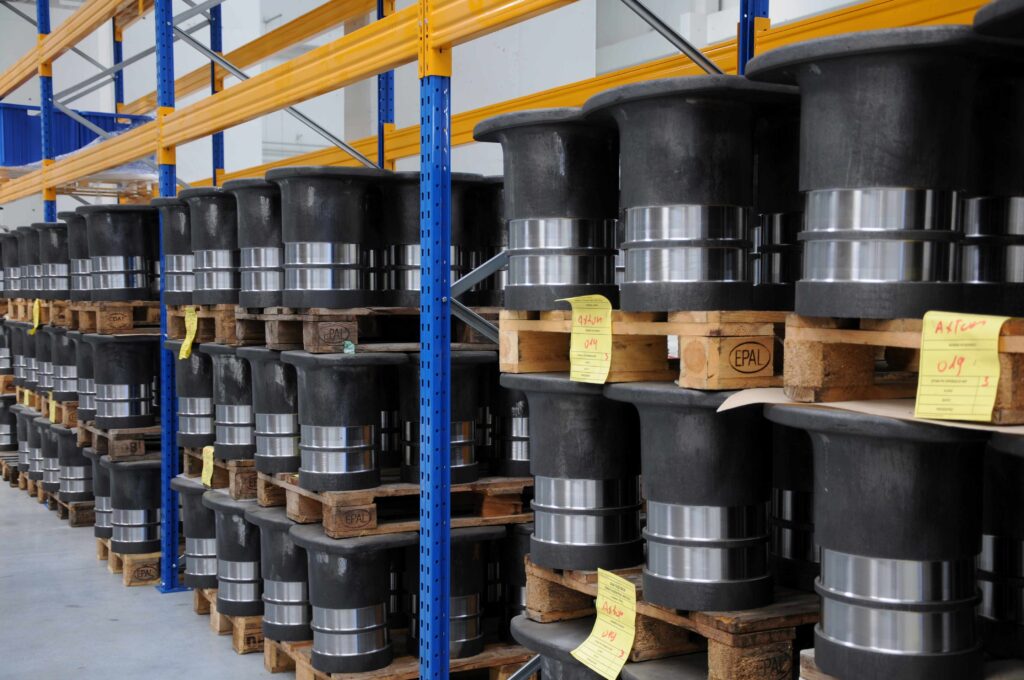CNC machining of large-size components is a completely different category of challenges than working with typical, small parts. When a part weighs several dozen kilograms, is several meters long, and must maintain a tolerance of hundreds of micrometers, every mistake becomes costly—both in terms of material and machine downtime. Therefore, planning such a process requires a different approach than with typical small parts.
At SIM Gdynia, we perform CNC machining of components weighing up to 500 kg for the machine, energy, defense, and automation industries.
Based on our experience, below we summarize the most important challenges, limitations, and best practices that technologists and production engineers deal with on a daily basis.
Spis treści
How exactly does large-scale CNC machining differ from standard machining?
In practice, we usually refer to “large dimensions” when:
- The part is longer than 1 meter,
- the weight of the workpiece exceeds several dozen kilograms,
- portal centers, large vertical lathes, or boring machines are needed for machining instead of typical compact lathes.
Such parts include, for example, machine bodies, base plates, welded frames, gear housings, and large-diameter bearing elements.
In their case, CNC machining must reconcile high accuracy with the limitations of the working area, lifting capacity, and rigidity of the entire system.
Added to this are logistics, more specifically the transfer of the workpiece by crane, the selection of suspension points, and the organization of the space around the machine so that loading and unloading are safe and repeatable.
Main technological challenges with large dimensions
With large components, typical machining problems begin to “scale up.” What is a minor inconvenience with a small workpiece can be a make-or-break factor for an entire series with a plate several meters long. The key challenges can be grouped into several areas:
- Vibration and system rigidity – long tool overhangs, thin-walled structures, and welded frames cause susceptibility to vibration. Incorrect selection of holders and parameters results in a wavy surface, noise, and accelerated tool wear.
- Thermal errors – during long runs and multi-hour cycles, the guides, spindle, and the part itself heat up. A dozen or so micrometers per meter may seem like a small value, but over a length of several meters, it quickly “eats away” at tolerances.
- Maintaining global tolerances – locally, the dimensions may be correct, but the flatness, straightness, or concentricity of the entire workpiece will still be outside the specification. With large dimensions, it is crucial to look at the part as a whole, not just at individual features.
- Programmingcomplexityandcollisionrisk – with long programs, 5-axis machining, and complex tooling, the risk of the tool colliding with the table, holders, or the workpiece itself increases. CAM simulation is indispensable here.
Machine, workpiece, and material limitations – real hard limits
Even the best machine park has objective geometric and dynamic limitations. In large-scale CNC machining, the following are particularly noticeable:
- Limited working area and table load capacity – sometimes it is impossible to avoid repositioning the workpiece, which introduces additional referencing errors,
- a decrease in geometric accuracy at extreme axis positions, which must be compensated for with an appropriate machining and measurement strategy,
- the need to reduce acceleration and speed so as not to induce vibrations in large moving masses.
Large dimensions often involve castings with allowances or welded structures. After rough machining, residual stresses are released, and deflections, twists, and local deformations appear. For this reason, the optimal process is usually divided into a roughing stage with a controlled allowance, followed by stress relief (thermal or “natural” – temporary) and a finishing stage focused on accuracy and surface quality.
How to approach the planning of CNC machining of large-size parts?
With large-size components, the effectiveness of machining largely depends on how the entire process is planned.
Unlike small-size parts, here every technological assumption affects not only quality, but also work safety and geometric stability. Therefore, it is worth basing the preparation of the process on a few key steps.
- Analysis of the design in terms of CNC machining
The first step is to evaluate the part in terms of tool availability, basing possibilities, and the sequence of operations.
In practice, this means comparing the design assumptions with the actual limitations of the machines and tooling.
Such an analysis allows you to establish reference points, predict the risk of deformation, and determine whether the part may require modular machining.
- Defining the process in two stages
Large parts require layered machining.
First, a roughing stage is planned, the purpose of which is the controlled removal of excess material, and only after the part has stabilized is the finishing stage carried out.
This division minimizes the impact of released stresses on the final dimensions and makes it easier to maintain overall tolerances.
- Selecting a machine tool for the nature of the workpiece
The choice of machine tool is not based solely on the size of the part, but also on its design and the distribution of machined surfaces.
For some components, a horizontal center with a large axis range will be more effective, while for others, a boring machine will be more suitable. At this stage, the required tooling and workpiece support method are also determined.
- Verification of the process in a CAM environment
For large dimensions, CAM simulation is not only used for collision control.
It allows you to assess how tools, holders, and the machine table will affect the possibility of smooth transitions and whether the machined surfaces are accessible without changing the bases.
This makes the process more predictable, and the setup on the machine is faster and without the risk of unplanned downtime.

Summary – large-scale CNC machining without surprises
Large-scale machining is an area where small errors have big consequences. The key to predictability is:
- Good planning of the technological path,
- conscious selection of machine tools and equipment,
- control of vibrations and thermal phenomena,
- metrology tailored to the scale of the detail.
If you are working on a project that requires CNC machining of large components and are looking for a partner who will not only manufacture the part but also help you optimize the process, send us your technical drawing. We will be happy to analyze your requirements, propose the technology, and prepare an offer tailored to your application.
